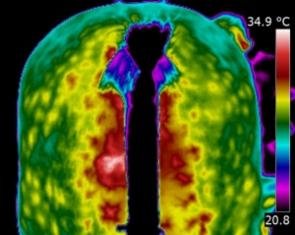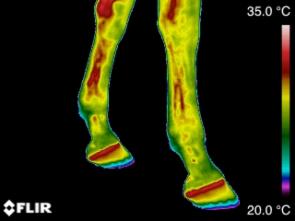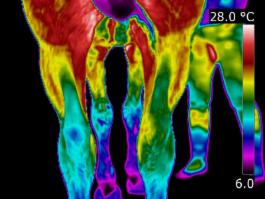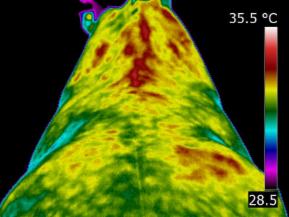EQUINE THERMOGRAPHY"Infrared Thermography is the science of acquisition and analysis
of thermal information from non-contact thermal imaging devices" |
In other words, it's knowing how to take correct images with an infrared camera and then being able to accurately interpret those images.
|
   |
Detecting
the source of discomfort can be challenging when the subject can’t
verbally communicate the location or extent of pain ~ Thermography can
help identify the source of pain.
|
Equine Infrared Thermal Imaging or Thermography is a non-invasive, non-contact, tool that uses the very latest infrared imaging equipment and computer software to detect minute differences in the horse’s thermal and neural condition. Thermography is a qualitative assessment of temperatures. The infrared camera measures heat emissions from the body, visible as a thermal image. It can quickly and efficiently identify areas that may require further investigation. Your vet can then make a decision on any treatment needed and thermography can then be used to monitor the recovery.
|
  
|
Anatomic
imaging such as Ultrasound, X-ray or MRI test and reveal the actual
state of structure and anatomy; a broken bone or tear in a structure
such as a tendon. These diagnostics are necessary to reveal the nature
and degree of breakdown that has already occurred in tissue. Physiologic
imaging is a function of metabolic action and reveals the physiology of
tissue as it is occurring now. Physiologic images can change and might
appear prior to anatomic disruption. Thermography (or thermal imaging)
is considered physiological imaging. Anatomic imaging is needed for
diagnosis after thermal (physiologic) imaging has pinpointed a problem
area.
|
   |
Infrared
Equine Thermography will help you to build an accurate picture of what
is going on beneath the surface of an individual horse. It provides the
horse owner and equine professional with an advanced visual aid with
which to locate heat, inflammation, tissue tone, cold, reduced blood
circulation and some affected nerve functions. A valuable addition to
existing diagnostic tools, thermal imaging is non-invasive, emits no
radiation and can be repeated as frequently as required.
|
At
the 1996 Olympic Games in Atlanta, where there was millions of dollars
worth of equipment available to the equestrian teams, the most requested tool was thermography.
It
is fast, portable, non-invasive and can detect injury sites before they
become lameness problems and can guide practitioners to specific
anatomic areas for study using other diagnostic techniques. It is
extremely useful when used by an experienced, well-trained thermographer.
|
|
Please note that Equine Thermographers provide a service in infrared imaging and interpretation, and do not make a diagnostic evaluation of the horse; a veterinarian is the only professional, by Law, who is qualified to make a medical diagnosis. However, by knowing 'where' the issues present I can help you make more informed choices, taking the right course of action.
|
| |


